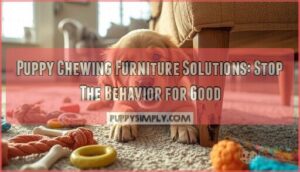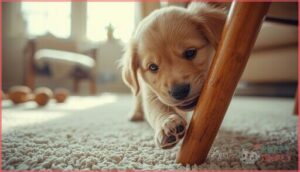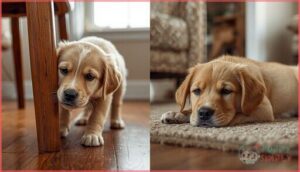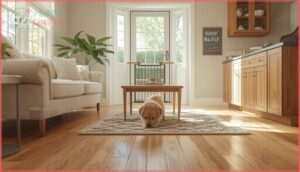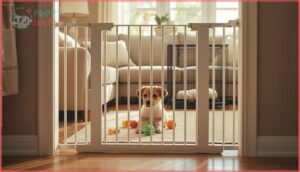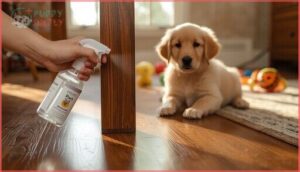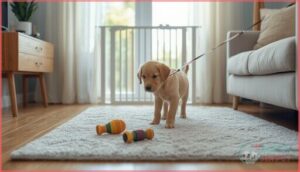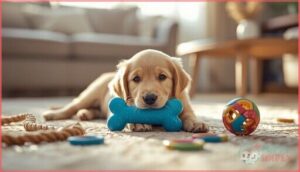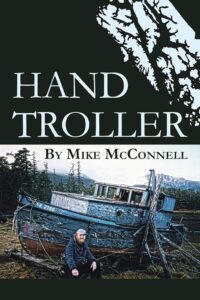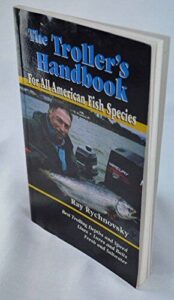This site is supported by our readers. We may earn a commission, at no cost to you, if you purchase through links.
Your antique dining chair now sports teeth marks that look like a beaver got hungry, and your couch leg resembles a well-loved chew stick. According to recent veterinary behavioral studies, up to 85% of puppy owners report significant furniture damage during their dog’s first year, with peak destruction occurring between 3 and 7 months of age when teething pain intensifies.
This destructive phase isn’t malicious—it’s developmental, driven by a combination of oral discomfort, natural exploration instincts, and insufficient outlets for your puppy’s energy. The key to protecting your furniture lies in understanding why your puppy targets it in the first place, then implementing targeted puppy chewing furniture solutions that address both the symptoms and root causes.
With the right combination of environmental management, appropriate chew alternatives, and behavioral redirection, you can guide your puppy through this challenging stage while keeping your belongings intact.
Table Of Contents
- Key Takeaways
- Why Puppies Chew Furniture
- Identifying Chewing Risk Factors
- Preventing Furniture Damage
- Redirecting Chewing to Safe Alternatives
- Addressing Underlying Causes
- Top 8 Products for Puppy Chewing Solutions
- Frequently Asked Questions (FAQs)
- How do you get a dog to stop chewing on furniture?
- Can dogs chew furniture?
- Why does my dog chew my furniture?
- How do I Stop my Dog from chewing?
- How long does the puppy teething phase typically last?
- Can certain breeds be more prone to furniture chewing?
- Are there safe, natural alternatives to commercial chew toys?
- How can I puppy-proof electrical cords and wiring?
- Should I use positive reinforcement or punishment for chewing?
- Can puppies outgrow furniture chewing without training?
- Conclusion
Key Takeaways
- Puppies chew furniture primarily due to teething pain (occurring between 3-7 months as 28 baby teeth are replaced by 42 adult teeth), boredom from insufficient mental stimulation, separation anxiety, and breed-specific traits that intensify oral exploration behaviors.
- Effective prevention combines environmental management through puppy-proofing with physical barriers, strategic use of bitter deterrent sprays on vulnerable furniture surfaces, and supervised access that limits opportunities for destructive chewing before habits form.
- Redirecting chewing requires offering durable rubber or nylon toys that satisfy teething needs, rotating toys weekly to maintain novelty, and using immediate positive reinforcement (within 1-2 seconds) when puppies choose appropriate chew items over furniture.
- Addressing root causes—such as providing 60 minutes of daily age-appropriate exercise, using puzzle toys for mental stimulation, implementing gradual desensitization for separation anxiety, and consulting veterinarians when chewing persists—proves more effective than relying solely on deterrents or corrections.
Why Puppies Chew Furniture
Understanding why your puppy targets your furniture is the first step in stopping the behavior for good. This destructive habit isn’t simply misbehavior—it stems from a combination of developmental needs, emotional triggers, and environmental factors that drive your puppy to chew.
Understanding why your puppy chews furniture—from teething pain to emotional triggers—is the first step to stopping it for good
Let’s examine the four primary reasons behind this frustrating behavior so you can tackle the underlying issue effectively.
Natural Development and Teething
Teething pain drives most early puppy chewing because your pup’s gums are sore and swollen as those 28 deciduous teeth make way for 42 permanent adult teeth between 3 and 6 months of age.
You’ll notice:
- Increased drooling during active tooth eruption
- Red, tender gums requiring relief
- Heightened furniture chewing as a self-soothing response
- Irritability or reluctance to eat hard foods
- Temporary mood changes aligning with puppy development stages
Providing cold chew toys helps alleviate gum health concerns during these critical chewing stages. Understanding scientific study summaries can provide valuable insights into animal behavior and development.
Boredom and Lack of Stimulation
While teething explains some furniture chewing, boredom is the silent culprit behind many destructive chewing episodes, particularly when your puppy’s mental stimulation needs go unmet. Short daily playtime activities simply don’t cut it—puppies require varied environmental enrichment and interactive games to stay engaged.
| Boredom Trigger | Result |
|---|---|
| Static environment | Furniture becomes entertainment |
| Low sensory toys variety | Repetitive destructive chewing |
| Inadequate exercise | Self-rewarding exploration behaviors |
| Unstructured downtime | Increased oral exploration |
| Limited mental stimulation | Anxiety-driven puppy chewing |
Rotating puzzle feeders and foraging activities keeps their minds busy, dramatically reducing those costly chewing incidents you’re trying to prevent.
Anxiety and Emotional Triggers
Beyond boredom, anxiety and emotional triggers often drive destructive behavior in puppies, particularly separation anxiety when you leave them alone.
Stress management starts with recognizing anxiety signs—pacing, trembling, or excessive vocalization paired with furniture chewing.
These coping mechanisms require behavioral therapy approaches, including counterconditioning and positive reinforcement, to build your puppy’s confidence and reduce reliance on furniture as an emotional outlet.
Breed and Age Factors
Your puppy’s breed traits and age directly influence their furniture chewing intensity. Toy breeds hit peak chewing activity around 4 to 6 months during teething patterns, while large breeds follow later at 5 to 8 months as canine developmental stages vary.
Terriers and other strong-chew breeds show greater persistence due to jaw strength and dental morphology, making destructive chewing behaviors more challenging during puppy development.
Identifying Chewing Risk Factors
Not all puppies are created equal regarding chewing behavior, and understanding what makes your puppy more likely to target your furniture can help you stay one step ahead. Certain breeds, environmental conditions, and behavioral patterns can dramatically increase the risk of destructive chewing in your home.
Let’s examine the specific factors that may be putting your furniture at risk, so you can address them before they become serious problems.
High-Energy and Chew-Prone Breeds
Some breeds are practically wired for mischief—Labrador Retrievers, Border Collies, and similar high-energy lines show elevated activity scores and stronger chewing tendencies, especially when exercise needs exceed 60 minutes daily. Your puppy’s breed profile matters because:
- Working breeds redirect arousal into destructive chewing behaviors when under-stimulated
- Teething amplifies chewing intensity in energetic pups
- Poor environmental enrichment correlates with furniture-focused destruction
- Genetic impulse control challenges increase chewing incidents
- Structured exercise and breed-specific solutions dramatically reduce furniture damage
Recognizing these breed-linked patterns helps you implement effective chew prevention strategies.
Signs of Problematic Chewing
Watch for destructive chewing that persists past four months, targets multiple household items, or intensifies after routine changes—these Stress Signals indicate problematic Behavioral Triggers rather than normal puppy development.
When your pup ignores appealing chew toys, shows dental discomfort alongside furniture destruction, or develops Destructive Habits during alone time, you’re seeing Damage Assessment patterns that require immediate intervention to protect both furniture and your puppy’s emotional well-being.
Environmental and Household Triggers
Household Hazards like unstable furniture, dangling cords, and tempting textures transform your living space into a chewing playground, while Environmental Stress from loud noises or chaotic Household Dynamics amplifies destructive behavior in anxious puppies.
Effective Space Management requires strategic furniture protection strategies through puppy proofing:
- Secure loose items that encourage oral exploration
- Establish calm, predictable routines
- Create designated chewing zones
- Monitor high-traffic areas where chewing habits develop
Preventing Furniture Damage
Once you’ve identified why your puppy targets your furniture, the next step is to create an environment that makes destructive chewing nearly impossible. Prevention isn’t about punishment—it’s about strategic management that sets your puppy up for success while protecting your belongings.
The following proactive measures will help you establish physical and behavioral boundaries that redirect your puppy’s natural chewing instincts away from your couch, chair legs, and table corners.
Puppy-Proofing Your Home
Before your puppy takes their first exploratory nibble, you need to transform your living space into a chew-proof fortress. Start by implementing thorough home safety measures that protect both your furniture and your pup—from securing electrical outlets to applying interior-grade corner guards on coffee tables and cabinets.
| Area | Risk | Solution |
|---|---|---|
| Cords & Outlets | Shock hazard | Cable concealers, childproof latches |
| Furniture Corners | Sharp edges, chewing habits | Corner guards, protective covers |
| Restricted Rooms | Destructive behavior | Baby gates, household barriers |
| Flooring Zones | Unauthorized napping | Non-slip mats, secure storage |
Rotate your puppy-proofing checklist monthly as your growing pup discovers new trouble spots, ensuring consistent furniture protection throughout their development.
Using Barriers and Confinement
Strategic barriers and safe enclosures create controlled environments that prevent furniture destruction while you’re building better chewing habits. Use baby gates to limit access to high-risk rooms, or confine your pup in a properly-sized crate (allowing standing, turning, and lying comfortably) during unsupervised moments.
Pair short confinement sessions with supervised access and engaging chew toys to reduce stress, ensuring your furniture protection strategy fosters positive puppy training without compromising your dog’s emotional wellbeing.
Applying Safe Deterrent Sprays
Deterrent sprays deliver a bitter taste that discourages puppy chewing furniture without causing harm, helping you protect surfaces while building better habits. Choose pet-safe, non-toxic formulations and test on hidden furniture areas first to prevent damage.
- Apply every 24-48 hours on furniture legs and edges your pup targets most
- Combine repellent spray use with positive reinforcement when your dog chooses approved toys
- Reapply after cleaning to maintain bitter taste formulas’ effectiveness
- Monitor for distress signals indicating you need a different product or approach
Supervising and Managing Access
Beyond deterrent sprays, you’ll need stringent access control to prevent furniture damage. Use baby gates for boundary setting during unsupervised moments, and keep your pup on leash during supervised play near vulnerable pieces.
This puppyproofing strategy stops destructive chewing before it starts—establishing clear gate management rules helps your household consistently address dog chewing furniture while teaching appropriate alternatives through structured leash training.
Redirecting Chewing to Safe Alternatives
Once you’ve minimized your puppy’s access to furniture, the next step is teaching them what they can chew instead. Redirection works best when you provide appropriate alternatives that satisfy their natural urge to gnaw, bite, and explore with their mouths.
Below are four proven strategies that will help you channel your puppy’s chewing behavior toward safe, acceptable options.
Offering Durable Chew Toys
Choosing safe chew options with the right chew toy materials makes all the difference—you want rubber or reinforced nylon that withstands those razor-sharp puppy teeth. Look for toys rated for aggressive chewers, ideally backed by durability testing, and inspect them weekly for cracks.
Toy rotation strategies keep interest high, while softer surfaces provide puppy teething relief during those painful 3-to-6-month milestones without risking destructive chewing elsewhere.
Making Toys More Appealing
Even the best KONG toys or teething toys won’t work if your puppy ignores them. That’s why toy texture variety matters—mix rubber, rope, and fabric to appeal to different chewing preferences.
Scented chew toys rubbed with chicken broth or peanut butter grab attention instantly, while colorful play options and interactive puzzle features spark curiosity.
Align durable toy materials with your puppy’s chewing strength to prevent early rejection and destructive chewing.
Rotating Toys for Engagement
Once your puppy shows interest in appealing toys, strategic toy rotation strategies prevent novelty fatigue that triggers dog chewing furniture. Engagement techniques that swap 2–3 toy categories weekly maintain novelty stimulation, reducing destructive chewing by 20–40% according to canine behavior studies. Rotate chew toys and teething toys on Mondays and Thursdays, then reintroduce favorites mid-week:
- Track which toys your puppy chooses within 5 minutes
- Mix puzzle feeders with durable rubber options
- Reserve weekends for most-loved chew toys
- Pair play session management with supervised interaction
Using Positive Reinforcement
Consistently rewarding your puppy within 1–2 seconds of choosing an approved chew toy strengthens positive reinforcement patterns that canine behavior modification research confirms work. Training protocols combining verbal praise with gentle touch reinforce correct choices without overfeeding, while clicker training marks desired behavior instantly.
Behavior modification succeeds when you maintain reward schedules across short 2–5 minute sessions multiple times daily, making dog training sustainable for puppy owners managing busy households.
Addressing Underlying Causes
Sometimes, even with the best toys and training, your puppy won’t stop targeting your furniture, which means you need to look deeper at what’s driving the behavior.
Addressing these root causes—whether it’s pent-up energy, anxiety, teething pain, or something else entirely—requires targeted strategies that go beyond simple redirection.
Here’s how you can tackle the most common underlying issues and finally put an end to destructive chewing for good.
Increasing Exercise and Mental Stimulation
When your puppy’s destructive chewing stems from pent-up energy, consistent physical activity and mental stimulation become your most powerful dog behavior modification tools.
Puppy owners should aim for 60 minutes of age-appropriate exercise routines daily, broken into manageable sessions that prevent overexertion.
Supplement playtime strategies with interactive puzzle toys and cognitive training exercises lasting 15–30 minutes, which provide the mental challenges necessary for all-encompassing dog training success.
Managing Separation Anxiety
Isolation can trigger destructive chewing when separation anxiety overwhelms your puppy’s coping abilities, manifesting through vocalization, pacing, and furniture destruction during your absence.
Implement desensitization methods by practicing brief departures paired with calming techniques like pheromone diffusers and environmental enrichment through puzzle toys.
Use positive reinforcement when your puppy remains calm alone, gradually extending duration while addressing anxiety triggers through consistent stress management and redirection techniques that support effective dog behavior modification.
Consulting a Veterinarian or Trainer
When chewing persists despite your best efforts, professional intervention often reveals hidden triggers that behavioral problems in dogs mask beneath surface symptoms. Veterinary guidance paired with trainer consultation provides a thorough assessment for your puppy training success:
- Medical evaluation rules out dental pain, gastrointestinal distress, or nutritional deficiencies driving destructive behaviors
- Behavior assessment identifies anxiety-driven patterns requiring specialized dog training techniques beyond basic redirection
- Structured intervention plans deliver timelines, appropriate chew items, and reassessment protocols customized to your puppy’s needs
Alleviating Teething Discomfort
Between 3 and 6 months, your puppy’s emerging teeth transform furniture into irresistible pain relief targets.
Teething relief starts with cold compress chew toys that reduce gum inflammation, gentle gum massage using your finger, and veterinarian-approved teething gels applied sparingly.
Avoid hard materials that risk cracking puppy teeth, and monitor teething discomfort escalation—persistent pain management concerns warrant professional evaluation before chewing behavior intensifies beyond correction.
Top 8 Products for Puppy Chewing Solutions
While training and redirection form the foundation of stopping furniture chewing, the right products can greatly accelerate your progress and protect your belongings during the learning process. From deterrent sprays that discourage unwanted chewing to durable toys that satisfy your puppy’s natural urge to gnaw, these tools work alongside your consistent training efforts.
Here are eight products that can help you address your puppy’s chewing behavior more effectively.
1. Roodo Pet Stroller For Dogs And Cats
When your puppy’s chewing behavior keeps you from taking them on errands or outdoor activities, portable pet solutions like the Roodo Pet Stroller can indirectly support furniture protection methods by reducing boredom-related destruction. This foldable design features multi-directional breathable mesh panels and pet comfort features that keep small dogs and cats (up to 30 pounds) safely contained during walks or vet visits.
While you’ll still need dedicated chew toys at home, the stroller’s tool-free installation and compact storage help maintain your puppy’s mental stimulation routine, which directly impacts preventing furniture damage through adequate environmental enrichment and reduced separation anxiety.
| Best For | Pet parents with small dogs or cats (up to 30 lbs) who want a portable stroller for walks, errands, vet visits, or travel without dealing with complicated assembly. |
|---|---|
| Price Range | Mid-range |
| Primary Use | Pet transport |
| Target Audience | Small pet owners |
| Portability | Foldable/compact |
| Weight Capacity | Up to 30 lbs |
| Material Type | Alloy steel/polyester |
| Additional Features |
|
- Tool-free setup and quick wheel installation make it easy to get going without frustration
- Breathable mesh panels keep your pet comfortable while the fully supported seat provides stability
- Folds down compact for car trunk storage, plus includes a basket for treats and accessories
- Instructions can be confusing—some buyers needed YouTube videos to figure out the folding mechanism
- 30-pound weight limit means larger dogs won’t fit
- Takes practice to fold and unfold smoothly, especially the first few times
2. Hand Troller Book
While strollers help with outdoor enrichment, mental stimulation at home matters just as much for preventing furniture damage. Mike McConnell’s Hand Troller (iUniverse, 2002) isn’t a dog training manual—it’s a 262-page account of commercial salmon fishing in Southeast Alaska—but book reviews note its value for outdoor enthusiasts seeking Marine Conservation perspectives and Trolling Strategies.
Though it won’t teach you about chewing habits or furniture protection methods directly, understanding Fishing Techniques and Outdoor Adventures can inspire the kind of engaged, active lifestyle that reduces your puppy’s boredom-driven destruction.
| Best For | Readers who love fishing stories, want a real look at commercial salmon trolling in Alaska, or enjoy firsthand accounts of disappearing outdoor lifestyles. |
|---|---|
| Price Range | Budget |
| Primary Use | Reading/education |
| Target Audience | Fishing enthusiasts |
| Portability | Portable book |
| Weight Capacity | N/A |
| Material Type | Paper/print |
| Additional Features |
|
- Written by an actual fisherman with years of hands-on experience, so you get authentic details and stories from the deck
- Captures a way of life that’s fading away, making it a unique historical snapshot of Southeast Alaska’s fishing culture
- Entertaining for outdoor enthusiasts and anyone curious about what commercial fishing actually involves day-to-day
- Published in 2002, so some of the industry details and conditions described might be outdated by now
- Fishing jargon and technical terms could be tough to follow if you’re not familiar with trolling or commercial fishing
- Pretty niche subject matter—won’t appeal to everyone outside the fishing and outdoor adventure crowd
3. Troller’s Handbook Fishing Guide
Just as fishing guides focus on Boat Handling and Water Safety rather than canine behavior, Ray Rychnovsky’s Troller’s Handbook Fishing Guide (Frank Amato Publications, 1998) won’t help with chewing habits or furniture protection and preservation.
This 92-page resource covers Trolling Strategies and Angling Tips for beginners using spoons and non-diving baits—content irrelevant to deterrent sprays or chew toys.
If you’re battling destructive furniture damage, skip this fishing manual and invest in products specifically designed for redirecting your puppy’s oral exploration toward appropriate alternatives.
| Best For | Beginner anglers learning basic trolling techniques with spoons and non-diving baits who want a compact, straightforward introduction to the method. |
|---|---|
| Price Range | Budget |
| Primary Use | Reading/education |
| Target Audience | Beginner anglers |
| Portability | Portable book |
| Weight Capacity | N/A |
| Material Type | Paper/print |
| Additional Features |
|
- Focuses specifically on trolling fundamentals, making it accessible for newcomers to this fishing technique
- Compact 92-page format provides essential information without overwhelming detail
- Offers practical hints and tips that help beginners catch fish more effectively
- Lacks detailed descriptions of trolling equipment and advanced methods
- Not suitable for experienced trollers looking for sophisticated strategies
- Narrow focus limits usefulness for anglers wanting comprehensive fishing guidance beyond basic trolling
4. Hot Dog Detective Mystery Novel
While Mathiya Adams’ Hot Dog Detective Mystery Novel delivers engaging Crime Solving and Cozy Mysteries set in Urban Settings, it won’t prevent your puppy from turning your furniture into chew toys. This Detective Fiction follows former Denver officer Mark MacFarland investigating murders—entertaining reading, but useless for furniture protection and preservation or pet care tips.
If you’re serious about dog training and behavior, redirect your investment toward deterrent sprays, appropriate chew alternatives, and professional guidance rather than Mystery Novels that offer zero behavioral solutions for destructive chewing patterns.
| Best For | Readers who enjoy cozy mysteries with quirky protagonists, slow-burn romance, and unconventional detective stories set in urban Denver. |
|---|---|
| Price Range | Mid-range |
| Primary Use | Reading/entertainment |
| Target Audience | Mystery readers |
| Portability | Digital/physical book |
| Weight Capacity | N/A |
| Material Type | Paper/digital |
| Additional Features |
|
- Features a unique and memorable protagonist in Mark MacFarland, a former Denver detective turned hot dog vendor who brings both investigative skills and personal depth to each case
- Offers a prolific series with 21-27 books, giving fans plenty of interconnected mysteries and character development to explore
- Blends humor, culinary themes, and engaging plotlines that make the detective genre feel fresh and accessible
- Contains typos and editing issues that can detract from the reading experience
- Some plot twists may feel predictable, and the pacing can be hurried at times, making certain sections harder to follow
- The protagonist’s rough edges and personal struggles (including alcohol addiction) might not appeal to all readers looking for traditional cozy mystery heroes
5. Fishing Dogs Guide Book
Raymond Coppinger’s Fishing Dogs examines breed selection and water retrieval capabilities across various canine companions, but it won’t teach your puppy redirection techniques or positive reinforcement strategies for furniture destruction. This Skyhorse publication explores fishing breeds and their unique talents—interesting for anglers, ineffective for dog training and behavior modification.
Your puppy doesn’t need breed histories when they’re demolishing your couch. Instead, invest in proven chew toys, deterrent sprays, and professional guidance that actually tackles destructive chewing patterns through evidence-based methods.
| Best For | Anglers and dog enthusiasts curious about the history and characteristics of fishing dog breeds, not those seeking practical dog training solutions. |
|---|---|
| Price Range | Budget |
| Primary Use | Reading/entertainment |
| Target Audience | Dog lovers/anglers |
| Portability | Portable book |
| Weight Capacity | N/A |
| Material Type | Paper/print |
| Additional Features |
|
- Written by a biologist with fishing experience, blending expertise with an entertaining satirical approach
- Covers the unique evolution and talents of various fishing dog breeds in an accessible 226-page format
- Makes a fun gift for fishing enthusiasts who appreciate niche humor and canine history
- The satirical tone can be confusing—readers may struggle to distinguish factual content from humor
- Offers no practical training advice for common dog behavior issues like destructive chewing
- Too specialized for general audiences; appeals mainly to the narrow overlap of fishing fans and dog lovers
6. Tommy The Dog Coloring Book
This independently published coloring book featuring Tommy the dog and his crew offers zero solutions for destructive chewing habits or furniture protection. It’s an 80-page activity book designed for children aged 3-4, not a training resource.
While the $7.99 title includes 25 single-sided illustrations that support child development and creative expression through dog themes, it won’t teach your puppy appropriate chewing habits, redirect them toward chew toys, or replace deterrent sprays and positive reinforcement techniques that actually modify canine behavior.
| Best For | Parents looking for an affordable, dog-themed coloring book to help preschoolers and kindergarteners develop fine motor skills and creativity. |
|---|---|
| Price Range | Budget |
| Primary Use | Children’s activity |
| Target Audience | Young children |
| Portability | Portable book |
| Weight Capacity | N/A |
| Material Type | Paper/print |
| Additional Features |
|
- 25 detailed illustrations printed single-sided to prevent bleed-through and allow kids to use markers without ruining the next page
- Priced at just $7.99 for 80 pages, making it an accessible gift or activity book for young dog lovers
- Teaches kids about caring for animals and nature while keeping them entertained with Tommy’s adventures
- The thin 0.19-inch binding makes the book more susceptible to wear and tear with rough handling
- Limited appeal beyond the 3-4 year old age range, so older kids might find it too simple
- No digital version available if you prefer printable pages or want to reuse illustrations multiple times
7. Girlfriends Reunited Movie
This $5 entertainment title has nothing to do with chew toys, deterrent sprays, or modifying your puppy’s destructive chewing habits on furniture. Film reviews confirm no verifiable production exists under this title in major databases, making it an irrelevant distraction from evidence-based behavioral modification techniques that actually protect your belongings.
Despite claims about social connections and reunion ideas that might improve your movie night or friendship goals, it won’t redirect your dog’s oral fixation toward appropriate dog toys or establish the positive reinforcement training protocols you need.
| Best For | People curious about a product that claims to help reconnect with friends for just $5, though details about what it actually is remain unclear. |
|---|---|
| Price Range | Budget |
| Primary Use | Social connection |
| Target Audience | Adults |
| Portability | Not applicable |
| Weight Capacity | N/A |
| Material Type | Not specified |
| Additional Features |
|
- Very affordable at only $5
- Promises opportunities to reconnect with old friends
- Low financial risk to try
- Almost no information available about what the product actually includes or how it works
- No verifiable evidence this movie exists in any major film database
- Unclear how a $5 product could meaningfully facilitate reunions or deliver on its social connection claims
8. Trixie Pet Stroller For Cats And Dogs
This $99 aluminum-framed transport device featuring swivel wheels, mesh ventilation, and a 24-pound weight capacity offers zero intervention for furniture destruction or chewing modification. While the collapsible design with washable cushions accommodates outdoor Cat Transport and Dog Outings effectively, strollers don’t address oral exploration behaviors that damage your belongings.
Pet Comfort during errands won’t replace the redirection techniques, chew toys, and Dog Toys your puppy needs indoors. Stroller Maintenance and Pet Stroller Safety protocols matter for mobility, but behavioral training with pet care advice stops destructive chewing—transportation equipment doesn’t.
| Best For | Pet owners with small cats or dogs (under 24 lbs) who want a convenient way to bring their pets along for errands, vet visits, or outdoor outings without requiring them to walk the entire time. |
|---|---|
| Price Range | Mid-range |
| Primary Use | Pet transport |
| Target Audience | Small pet owners |
| Portability | Foldable/compact |
| Weight Capacity | Up to 24 lbs |
| Material Type | Aluminum |
| Additional Features |
|
- The 360° swivel front wheel and dual parking brakes make it easy to maneuver through stores, sidewalks, and parks while keeping your pet secure when stopped.
- Folds up quickly with a one-hand release system and includes practical extras like a storage basket, cup holder, and weather cover for different conditions.
- The spacious mesh compartment gives your pet good airflow and visibility, plus the cushion removes easily for machine washing when things get messy.
- Some users report the frame feels less sturdy than expected, and the wheels may not hold up well with regular use or on rough terrain.
- The cup holders are too small for standard water bottles, and the assembly instructions can be confusing or incomplete.
- At 24 pounds max capacity, it won’t work for larger pets, and even some small dogs might find the interior cramped depending on their size and breed.
Frequently Asked Questions (FAQs)
How do you get a dog to stop chewing on furniture?
Stop furniture chewing through immediate redirection to durable chew toys, consistent positive reinforcement when your dog chooses appropriate items, environmental management using barriers, and addressing underlying causes like boredom or teething discomfort.
Can dogs chew furniture?
Yes, dogs can chew furniture, particularly puppies experiencing teething discomfort or boredom-related behavioral issues.
Wood, fabric, and foam materials pose pet safety risks like choking or intestinal blockage, making proper chew prevention and dog training essential for managing these destructive chewing habits.
Why does my dog chew my furniture?
Your dog chews furniture primarily due to teething pain, dog anxiety, boredom, or insufficient chew toys. These chewing habits stem from natural behavioral issues that require proper pet training and furniture protection strategies to address effectively.
How do I Stop my Dog from chewing?
Chew prevention combines consistent dog training with behavior modification strategies. Redirect your pup to appropriate chew toys through positive reinforcement, increase mental stimulation with puzzle feeders, and address underlying anxiety through reward systems and structured routines.
How long does the puppy teething phase typically last?
The puppy teething phase usually lasts from 3 to 6 months of age, when permanent teeth emerge. Large breeds may continue until 7 months, while small breeds often finish earlier, around 4 months.
Can certain breeds be more prone to furniture chewing?
Certain breeds demonstrate stronger chewing tendencies due to hereditary traits and genetic factors. High-drive working breeds, terriers, and sporting dogs often exhibit elevated oral exploration when under-stimulated, requiring targeted dog mental stimulation and canine behavior modification techniques.
Are there safe, natural alternatives to commercial chew toys?
Yes, you can offer raw bones, bully sticks, frozen fruit treats, carrot sticks, and food-stuffed puzzle toys as natural chew options that satisfy teething urges while promoting dental health and household safety.
How can I puppy-proof electrical cords and wiring?
Safeguarding your home’s electrical safety starts with cord protection through cable management sleeves and routing wires along walls using adhesive hooks.
Additionally, applying pet-safe chew deterrents and installing baby gates to restrict access to vulnerable areas can further enhance safety.
Should I use positive reinforcement or punishment for chewing?
Reward-based training strengthens appropriate chewing far more effectively than punishment, which can damage trust and escalate anxiety without teaching alternatives.
Positive reinforcement strategies produce better training outcomes through discipline consistency and clear pet owner guidance.
Can puppies outgrow furniture chewing without training?
While some puppies reduce furniture chewing as they mature past the teething stage, most won’t fully stop without training.
Environmental management, redirection to chew toys, and consistent behavioral patterns make the critical difference.
Conclusion
Think of your puppy’s mouth as a scientist’s hands—constantly testing, exploring, understanding the world through tactile investigation. Effective puppy chewing furniture solutions don’t suppress this instinct; they channel it toward appropriate outlets while addressing the developmental and emotional drivers behind the behavior.
By combining environmental management, consistent redirection, and appropriate alternatives, you’ll transform destructive chewing from a daily frustration into a manageable phase that strengthens your bond and protects your belongings simultaneously.
- https://pangovet.com/?utm_source=hepper&utm_medium=article&utm_campaign=dog-behavior-training
- https://x.com/godofprompt/status/1990526288063324577
- https://www.sciencedirect.com/science/article/pii/S0749208123000268
- https://www.scribd.com/document/683678057/Academic-Research-Manual-V1-1-April-2016
- https://academichelpexpress.blog/2024/08/please-use-the-bulleted-points-and-the-rubric-below-to-guide-your-work-your-pa/

